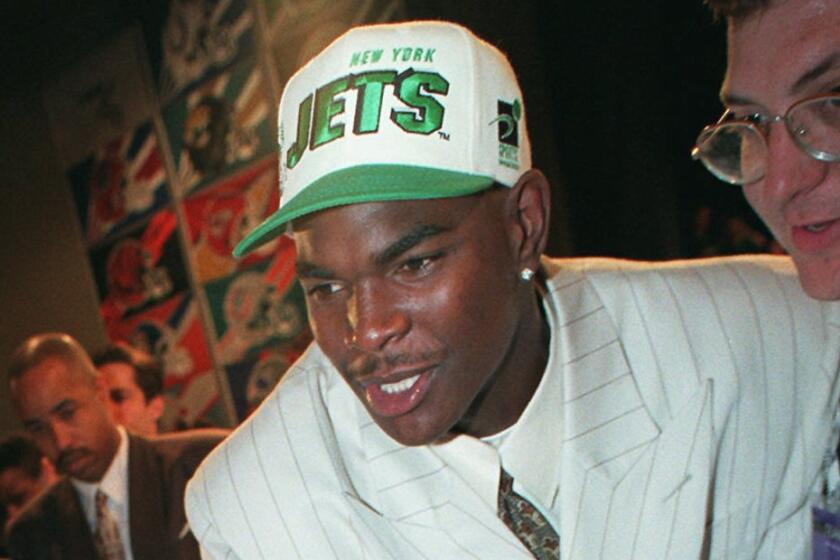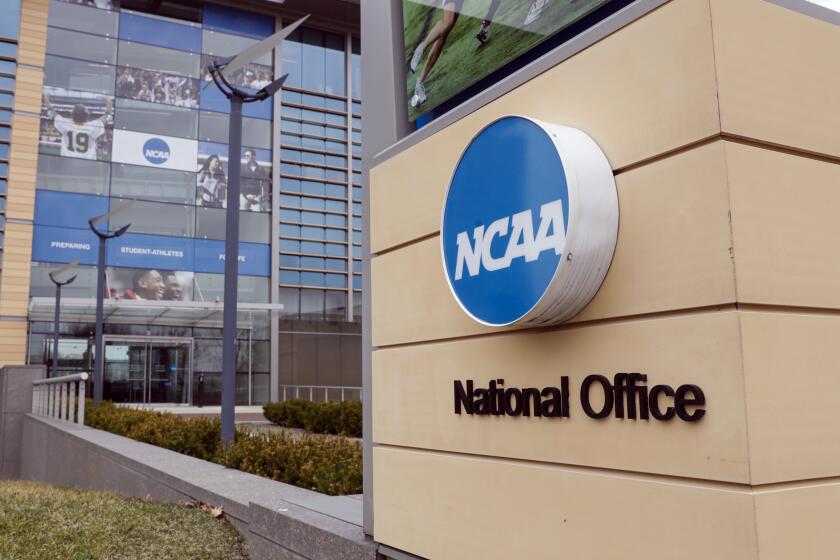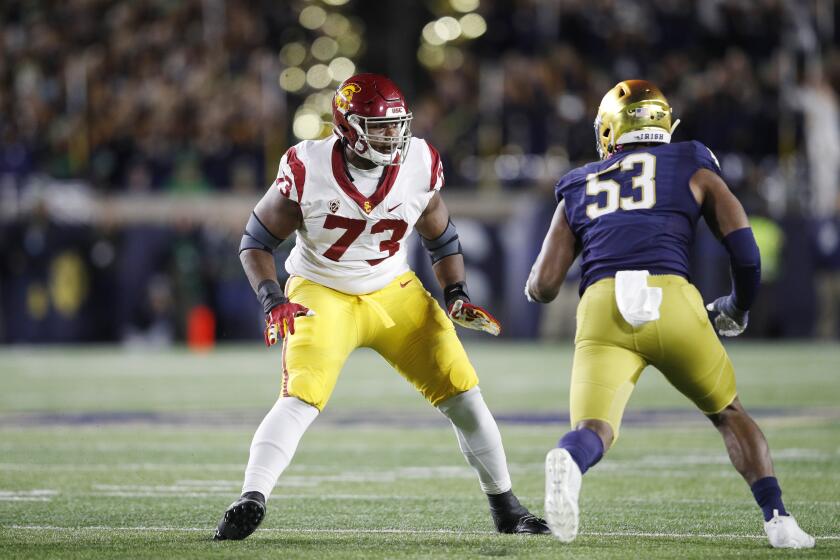How USC is experiencing a bold recruiting renaissance even during coronavirus crisis
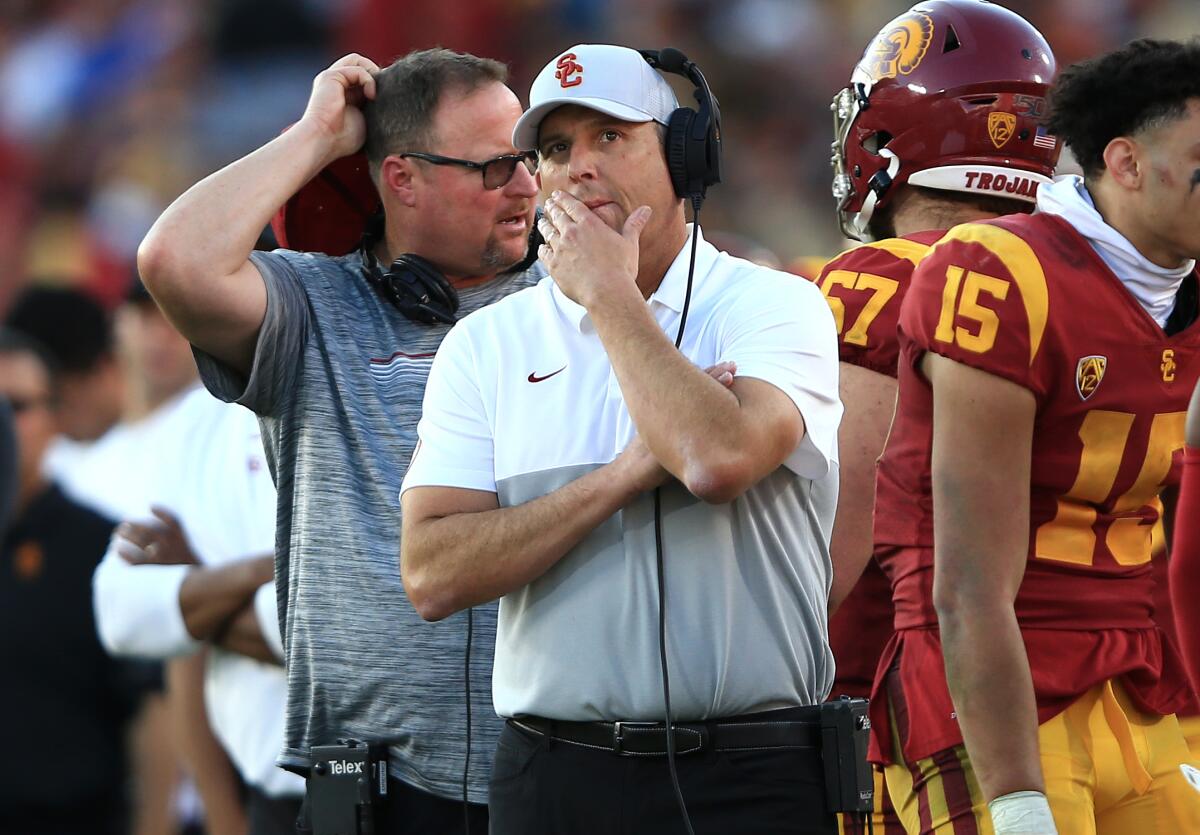
- Share via
When Donte Williams first boldly proclaimed his plans to “Take back the West” three months ago, USC’s new cornerbacks coach hadn’t planned on mounting that conquest from his living room.
This spring was supposed to mark his long-awaited homecoming, the end of a winding path which began at Culver City High and led to his return, two decades later, as one of college football’s most decorated recruiters.
In Los Angeles, Williams understood his work was cut out for him. But after a pair of seasons spent plucking top prospects from the Southland, his decision to leave a well-oiled machine at Oregon for a reclamation project at USC was hailed as the first major step in returning the Trojans to their perch atop West Coast recruiting.
Williams wasn’t shy in making such pronouncements himself. In February, he declared that the Trojans would be a “trendsetter,” taking back territory they rightfully owned. “I came here to make sure we’re respected and feared,” he promised.
His swagger was an adrenaline shot to the heart of an operation that USC’s new leadership knew had become stagnant. But a month later, as seasons were canceled and campuses were closed amid the COVID-19 pandemic, the recruiter at the center of USC’s rebuilt operation was the one stuck in place, a thousand miles away from L.A.
Williams drove to Oregon at the beginning of March to prepare his home to be sold. As April has turned into May, he’s still there, with no clue how much longer he must stay.
There’s not much clarity to be found anywhere around college football these days. No one knows if the season will start on time — or at all. Meetings are now virtual. Schemes are installed over Zoom. Prospect evaluation is on indefinite hold, with camps and visits canceled for the foreseeable future.
Which school has the most No. 1 NFL draft picks of all-time? This is where the rivalry between USC and Notre Dame flares up once again.
One facet of college football, however, rages on unabated through the quarantine.
“Recruiting,” Williams says, “is still nonstop.”
Which is to say, for Williams, the days aren’t all that different than before. He’s still answering texts from recruits at 2 a.m., still talking to moms, dads and cousins, still building relationships brick by brick, the only way he knows.
Except now, without practices and position meetings and all the usual minutiae consuming every waking moment of a coach’s day, Williams has never had so much time. He’s filled most of it talking to recruits, most of whom have never been so accessible.
“[We’re] working even harder being at home,” Williams says. “I wake up at the same time in the morning, but at night, I’m wide awake. It’s literally work all day.”
Those extra hours appear to be paying dividends. Months after revamping its staff in the wake of its most disappointing recruiting haul in recent memory, USC convinced three four-star 2021 prospects to commit over a four-day period in April — or one more than they had landed over the entire recruiting cycle.
The staff, which includes six new assistants, has done particularly well in California, as five of the state’s top 25 prospects are committed to USC. Its last class had one.
The Trojans’ 2021 class ranks seventh in the nation (and first in the Pac-12) in the 247Sports composite rankings, 47 spots higher than where it finished last season.
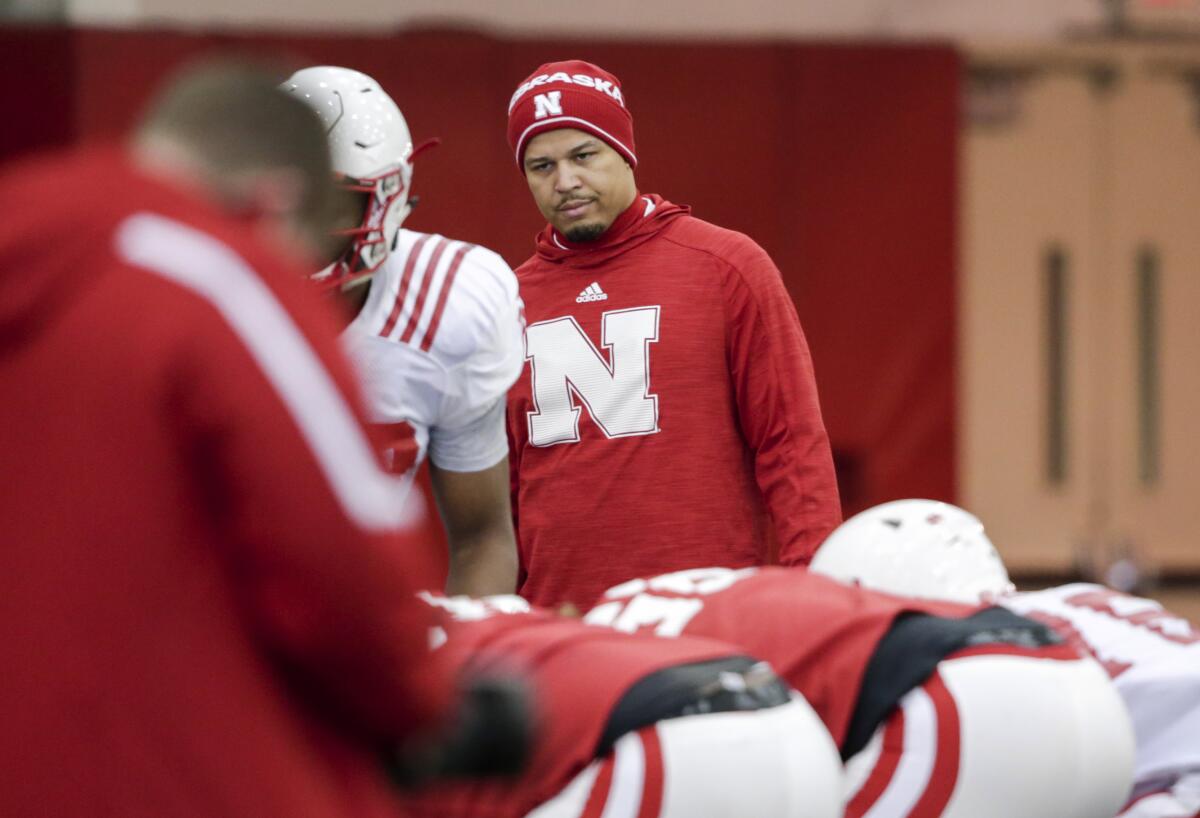
“I don’t want to say we’re outworking other schools,” says Spencer Harris, USC’s director of player personnel, “but we feel like we’re working our asses off, and we’re getting results.”
***
The groundwork for USC’s at-home recruiting success was laid in early January, long before COVID-19 closed college football. With a poor early signing day barely in the rearview mirror, coach Clay Helton met with Brandon Sosna, the athletic department’s new chief of staff, to discuss how to fix its recruiting operation.
Sosna watched that signing day from his old office in Cincinnati, taking notice each time top targets of the Trojans signed elsewhere. A week later, in one of his first official days at USC, Sosna met with Joseph Wood, the football program’s chief of staff, to understand the scope of issues papered over by the previous administration.
Among the most pressing was recruiting. USC had regularly signed top-20 classes in recent years, but the program’s dwindling status among top Southland prospects was no secret. Local high school coaches whispered about complacency on USC’s staff. Other staffers were spread too thin; two left the program in 2018, telling The Times that USC was “severely undermanned.”
The new leadership was especially stunned to find that the team’s director of scouting, Trey Johnson, also was running all of USC football’s social media accounts (Johnson still pulls double duty).
“Some people had come to an understanding that things needed to change,” Harris said.
Helton was chief among them. The coach had borne the brunt of blame for USC’s recent downturn in recruiting, but the reality was more nuanced. Interviews with coaches, staffers and administrators paint the picture of an operation drastically short on resources, devoid of proper strategy and structure, with a head coach in need of guidance on how to turn it around.
The Jan. 3 meeting with Sosna was one of the first steps. Helton was adamant about his need for more staff and resources dedicated to recruiting. So Sosna asked Harris and Wood to put together an Excel analysis of every major college football program’s support staff and how much they spent.
To maximize return on any investments in recruiting, Helton — who fired two coordinators the day after a Dec. 27 loss to Iowa in the Holiday Bowl — came to understand further staff changes would be necessary. Over the coming weeks, he and Sosna met several times to scrawl the names of coaches they saw as “elite talents” on a whiteboard wishlist.
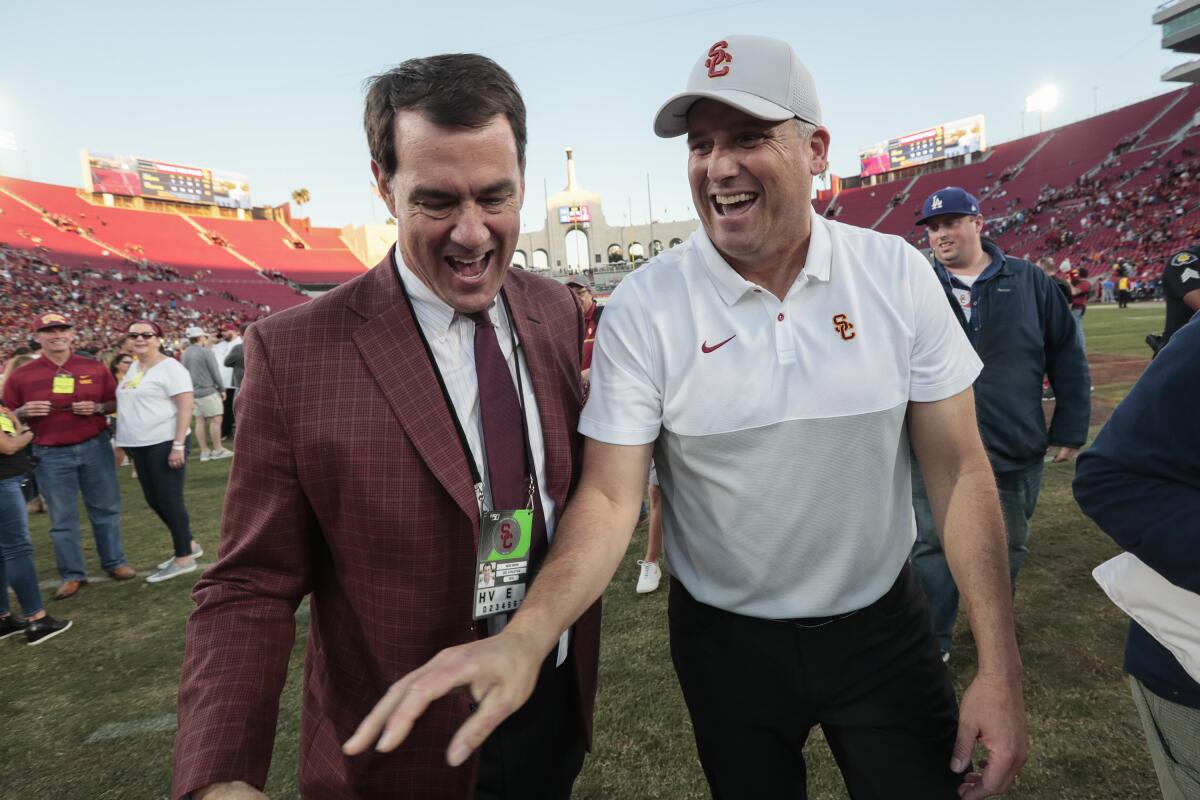
“Rather than say, ‘Oh, we can’t get him,’ our message was, ‘Hey, let’s go to work on it,’” athletic director Mike Bohn said in January.
Final paperwork was drawn up for USC to hire Louisiana State defensive coordinator Dave Aranda, whose unit helped the Tigers win the national title. Aranda hit it off with Helton, and USC was prepared to pay top dollar to close the deal with the Redlands native, who was the nation’s top paid coordinator at $2.5 million a year.
But when Virginia Tech’s Justin Fuente rebuffed Baylor for its head coaching position, the job went to Aranda.
USC hired former Texas defensive coordinator Todd Orlando instead. It was a decidedly less splashy hire, but did leave resources for an assistant USC believed most capable of jump-starting recruiting.
USC wasn’t the only team targeting Williams, but it was perhaps the most relentless in its clandestine pursuit of the man selected the Pac-12’s recruiter of the year. Sosna likened the process to “a Zero Dark Thirty operation,” in which he, Bohn, Helton, Orlando, receivers coach Keary Colbert and director of player development Gavin Morris all played a role in selling Williams on a return to L.A.
“All those people were on the same page,” Williams said. “That’s powerful. It showed me that there was vision and a path.”
The symbolism of his arrival wasn’t lost on anyone at USC. Inside the program, his hire felt like a turning point. Outside, it was a resounding public endorsement. Top recruits took immediate notice; within his first two months, three four-star defensive backs committed. Many more expressed interest.
USC’s remaining hires followed a similar formula, doubling down on energy and recruiting acumen. Safeties coach Craig Naivar came along with Orlando from Texas, where he was widely respected on the recruiting trail. Special teams coach Sean Snyder was viewed as one of the best in the nation at his position when he left Kansas State. Defensive line coach Vic So’oto, 32, was hired from Virginia, giving USC an up-and-coming recruiter with ties to the Polynesian community as well as East Coast connections.
In a lawsuit filed Thursday, women from three universities accuse the NCAA of not doing enough to protect women from violence by male athletes at colleges.
“We’re all aggressive, type-A personalities,” Orlando said. “That’s unique that you get a whole room of people who are good at their jobs ... but also understand the importance of recruiting.”
The staff spent only a month together before the pandemic struck, but meshed almost instantly. Now, they meet twice weekly on Zoom to discuss recruiting strategy. In the days between, they communicate routinely via text thread, their usual outward energy translated into a steady stream of GIFs.
“The juice from this whole staff,” Helton said, “has been amazing to me.”
The staff, in turn, has had similar praise for its head coach.
“It all flows through Clay,” Harris said. “He’s on the phone more often, with more people, around a bigger geographic area of the country. His [role] has definitely ramped up, just because of the people he’s surrounded with.”
The size of that surrounding operation is also in the process of ramping up. When Wood and Harris presented their spreadsheet analysis in January, the conclusion was just as Helton suggested: USC lagged considerably behind other top programs in terms of support staff.
Last season, the Trojans had four full-time support staffers dedicated to recruiting and four more focused on operations. Alabama’s most recent staff directory lists 10 for each department, along with 12 additional analysts in unspecified roles.
USC’s creative department was even further behind. While USC subsisted with a single graphic designer for football, Ohio State had a graphics staff of five. The story was the same with video production. Where Alabama boasted a team of five dedicated to football videos alone, USC football shared its creative video team with the 20 other teams at the school.
Before the pandemic, USC committed to add eight more staffers, six largely dedicated to recruiting and two in quality control. Four of those roles still are open, with USC in the midst of a hiring freeze. But the shift in strategy already has been evident within the department.
With recruits unable to visit campus through at least summer, that investment in a creative department has never been so crucial.
“The guy that was really good at Photoshop and Adobe Premiere and all that, he’s now the smartest guy in the room,” said Brandon Huffman, the national recruiting editor at 247Sports.
While coaches and prospects across the nation adjust to an uncertain recruiting landscape, USC is at least attempting to evolve along with it. The staff is leading virtual campus tours, “to bring that L.A. experience to the players,” So’oto said. They’ve produced hype videos and highlight reels for social media, hashtagged with catchy slogans like #TakeBackTheWest, #WeFIGHTasONe, or #LAndOfOpportunity. A coordinated round of GIFs, one from every member of the staff, now welcomes any new commitment.
“When you have that product,” Williams said, “when you put that out there, it reminds people of who you are.”
***
Jay Toia was one of the first 2021 prospects to commit to USC, choosing the Trojans two years ago. But as a busy summer approached for his recruitment, the Simi Valley Grace Brethren defensive tackle had started to wonder what else might be out there.
“I hadn’t been anywhere besides USC,” he said.
On March 17, Toia opened his recruitment, naming a top eight on Twitter that included USC. He made loose plans for more official visits — maybe he’d see LSU or Oregon or Michigan. Less than 48 hours after sending the tweet, the four-star prospect was confined to his home, erasing any hope of visits for the foreseeable future.
Official visits are unlikely until the fall, and by then, many 2021 prospects could be ready to put the process behind them. That could lead to a regionally focused rush in recruiting this cycle, helping schools in fertile recruiting grounds like USC. It also could hurt chances of convincing out-of-state prospects to head west.
USC’s lead in all-time NFL draft picks is down to one over Notre Dame after only two Trojans, Michael Pittman Jr. and Austin Jackson, were selected.
“If you’re not able to travel,” Huffman said, “that local school becomes sexier and sexier.”
That wasn’t the case with Texas four-star running back Brandon Campbell, who committed to USC last month. Nor was it a problem for Texas four-star wideout Quaydarius Davis, who committed Friday. Both chose USC without visiting campus, entirely based on their trust in the Trojans’ coaches.
USC may benefit from the home-field advantage with the nation’s No. 1 recruit.
Corona Centennial defensive end Korey Foreman recently decommitted from Clemson and has since listed USC as one of his top choices. In a podcast with 247Sports, Foreman said he was especially impressed by Helton’s “bold” decision to rebuild his coaching staff.
Whether the Trojans can reel in Foreman remains to be seen. But as recruiting rolls on through lockdown, losing him wouldn’t be for a lack of effort.
“We have so much time right now that the recruits are really feeling it,” Helton said with a laugh.
Toia can attest to that. He doesn’t believe COVID-19 will make him more likely to stay close to home, but USC’s relentless pursuit might. No school has contacted him more through the quarantine.
Williams doesn’t expect that energy to abate. How far it might propel USC, post-pandemic, is another question.
“The goals we set, we’re still far away from reaching,” Williams said. “But we’re on the same mission. We have the same vision. And it’s working.”
More to Read
Go beyond the scoreboard
Get the latest on L.A.'s teams in the daily Sports Report newsletter.
You may occasionally receive promotional content from the Los Angeles Times.

